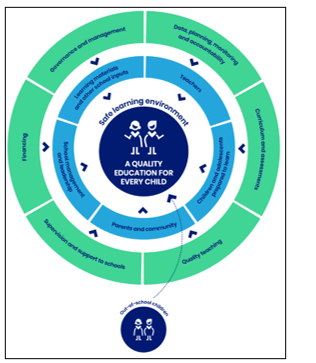Why in the News?
Recently, the Global Education Monitoring (GEM) 2025 Report was officially at the Paris Nutrition for Growth Summit (held in March 2025).
- The 2025 report suggests a student-centered, technology-driven, and inclusive approach to education—emphasizing personalized learning, digital integration, hybrid models, teacher empowerment, and community involvement to build skills and wellbeing for the future.
Key Findings of the 2025 GEM Report
|
What are the main challenges highlighted in the 2025 Global Education Monitoring Report?
- Gaps in Education and Nutrition Policies: There are significant gaps in policies and programs that prevent education from fully supporting better nutrition and health outcomes for students.
- About one billion teenage girls and women are affected by undernutrition and anemia, with the majority living in South Asia and sub-Saharan Africa. No region is on track to meet global nutrition targets for 2030.
- Exclusion and Inequality: Vulnerable and marginalized communities, including girls, children with disabilities, and those in low-income or conflict-affected areas, continue to face barriers to accessing quality education.
- 251 million children and youth are still not in school globally, with progress stagnating since 2015.
- For example, Central and Southern Asia, especially Afghanistan, Bangladesh, India, and Pakistan, have the largest populations of out-of-school children.
- Lack of Funding: Four in ten countries spend less than 4% of their GDP on education, which is below recommended levels and insufficient to meet education targets. Insufficient funding affects the ability to improve infrastructure, teacher training, and learning resources.
- Technology and Digital Divide: Unequal access to digital devices and the internet widens educational inequalities, particularly in low-income and marginalized communities.
- While technology can help, many teachers feel unprepared to use it effectively, and only half of countries have standards for developing teachers’ digital skills.
- Secondly, excessive or inappropriate use of technology can harm student learning and well-being, and issues like data privacy and e-waste are growing concerns.
- Leadership and Inclusion: School and system leaders often lack training and autonomy to promote inclusive education and respond to diverse student needs. There is a need for more professional development and support for leaders to foster inclusive, equitable, and quality education.
- Collaboration Gaps: There is a lack of effective collaboration between education, health, and nutrition sectors, which is necessary for holistic student development and learning.
What is a strong education system according to the Report?

- Education systems are composed of multiple actors and components that must work together to facilitate learning.
- Strong education systems are responsive and resilient, reaching all girls and boys with quality learning opportunities.
- Teaching and learning are at the heart of the education endeavor. Prepared learners, teachers and quality teaching, safe learning environments, and leadership and local accountability all play an important part.
- Global Partnership for Education (GPE) – (strategic plan for 2012 – 2025 that covers SDG too) works to strengthen and support education systems holistically to develop policies, prioritize and implement reforms, align external support with those priorities and jointly monitor and hold accountable all partners to achieve system-wide change. (as shown in the figure)
How does the 2025 report suggest addressing the drop in global aid to education?
- Increase Domestic Funding: The report emphasizes that the most sustainable source of education funding is from national governments themselves. It calls for countries to raise the volume, equity, and efficiency of their domestic education spending, ensuring resources reach the most marginalized groups.
- Innovative Financing Mechanisms: It recommends the use of new financing tools, such as matching funds and debt forgiveness mechanisms, to encourage greater investment in education.
- The Global Partnership for Education (GPE) Multiplier is cited as an example of expanding the impact of available funds.
- Flexible and Responsive Aid: The report advocates for more flexible grant-making processes that respond to country-specific needs and crisis situations. This includes accelerated financing mechanisms for countries in emergencies, which can be channeled through existing humanitarian pooled funds.
- Partnerships and Coordination: The report calls for stronger collaboration and alignment among governments, donors, civil society, and the private sector to maximize the impact of available resources and avoid duplication of efforts.
- Focus on Results and Accountability: Aid and domestic spending should be linked to clear, evidence-based priorities and monitored for impact. The report suggests using incentives and results-based financing to drive reforms and ensure accountability.
What were the other major four recommendations given by the 2025 Report? (Way Forward)

- Empower leaders and give them autonomy over decision-making in their schools, particularly around resourcing and pedagogy.
- Invest in professionalisation, ensuring leaders have management experience as well as teaching experience, that they are prepared to focus on inclusion and that they represent the local population.
- Ensure Inclusion is a part of school leader recruitment and training.
- Encourage collaboration between school leaders and staff, learners, and families and communities as key to building inclusive schools.
PYQ Relevance:
Q. National Education Policy 2020 is in conformity with the Sustainable Development Goal-4 (2030). It intends to restructure and reorient education system in India. Critically examine the statement. (UPSC CSE 2020)




